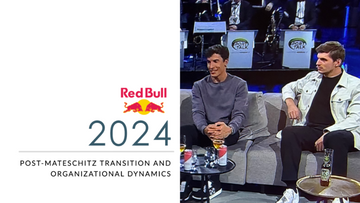2024 in Review: The Post-Mateschitz Transition and Organizational Dynamics
by Uwe Seebacher on Dec 17, 2024

As an international methods and structural scientist, I have always been deeply fascinated by organizations that push boundaries and redefine industries. Red Bull, with its bold approach to business, branding, and sports, has long intrigued me—not only for its success but for the way it operates as a living system of innovation, risk-taking, and performance.
This year, however, Red Bull’s journey has revealed something even more thought-provoking: the delicate interplay between leadership, identity, and resilience in times of transition. Watching the challenges faced by RB Leipzig and Red Bull Salzburg, contrasted with the continued success of Red Bull’s ice hockey and motorsports ventures, has been a remarkable study in organizational dynamics.
In this article, I reflect on the fascinating patterns emerging from Red Bull’s post-founder era—what has worked, what has wavered, and where the company might go next. These observations are shared as a blend of curiosity, respect, and the quiet belief that every challenge holds the seeds of renewal and growth.
Let’s explore together what Red Bull can teach us about leadership, resilience, and the art of navigating change.
1. The Persistent Power Vacuum
The absence of Mateschitz’s unifying vision has continued to reverberate across Red Bull’s ecosystem. While leadership at the corporate level attempted to centralize strategies, cracks emerged, particularly within sports teams like RB Leipzig and Red Bull Salzburg. Their struggles on the pitch reflected a deeper erosion of team identity and organizational sovereignty, as previously explored in my analysis of leadership vacuums and team performance.
- RB Leipzig's Turbulence: Despite glimpses of promise, RB Leipzig’s inconsistent performances mirrored their organizational struggles. The team grappled with a lack of mental resilience and clarity in leadership—challenges that were exacerbated by ongoing instability in Red Bull’s overarching direction.
- Red Bull Salzburg: Salzburg’s form also fluctuated. Once seen as a resilient, high-performing unit, the team’s identity appeared less defined, with leadership and decision-making processes at times disconnected from the pitch realities.
Both cases emphasize a recurring theme I explored throughout 2024: When leadership at the top falters, smaller units within the organization face an amplified impact on confidence, performance, and cohesion.
2. Success Stories: Lessons from Red Bull Ice Hockey and Red Bull Racing
In contrast, Red Bull’s ice hockey division, including EHC Red Bull München and EC Red Bull Salzburg, demonstrated sustained success throughout 2024. Their resilience can be attributed to localized leadership, a strong cultural foundation, and decentralized decision-making processes—factors I highlighted as critical for navigating times of uncertainty.
Similarly, Red Bull Racing, led by Max Verstappen’s exceptional performance and informal leadership, continued to thrive. Verstappen’s role transcended that of a driver, as he emerged as the focal point of unity and inspiration within the team. This reinforces one of my key reflections from earlier in the year: Informal leaders can often stabilize organizations when formal leadership is in transition.
Key Takeaway: The contrast between Red Bull’s football struggles and the stability of its ice hockey and motorsports ventures underscores the value of localized autonomy, clear cultural identity, and the emergence of strong, informal leadership.
3. Broader Organizational Insights
Red Bull’s challenges in 2024 reflect broader truths about organizations experiencing post-founder transitions:
- Identity Fragmentation: Without a clear, charismatic figure at the top, organizations risk losing alignment across their various units.
- Centralization vs. Autonomy: Red Bull’s attempts to centralize leadership have yielded mixed results. While centralization ensures cohesion, it can stifle flexibility and local decision-making, particularly in performance-driven entities like sports teams.
- The Mental Resilience Gap: Performance under pressure—whether on the pitch or in the boardroom—requires mental resilience, a factor that can erode in times of uncertainty.
These trends highlight areas where Red Bull must focus to ensure its continued success across its diverse ventures.
Outlook for 2025: Strategies for Organizational Resilience
As we look ahead, 2025 will be a defining year for Red Bull. Rebuilding organizational confidence and clarity must be a top priority. Here are some reflections and ideas on what could be done to address ongoing challenges and build resilience:
1. Decentralize Leadership with Strategic Alignment
While centralization can provide direction, Red Bull’s success stories in ice hockey and motorsports suggest that localized leadership works best in performance-oriented environments. To strike a balance:
- Red Bull should empower localized managers with decision-making authority while aligning them with overarching corporate goals.
- Regular communication loops between central leadership and regional units can ensure consistency without sacrificing agility.
Reflection: Can Red Bull design a hybrid leadership framework that marries autonomy with strategic cohesion? This balance could reinvigorate teams like RB Leipzig and Red Bull Salzburg.
2. Invest in Mental Resilience and Team Identity
To address the confidence and cohesion issues observed in 2024:
- Sports Psychology Programs: Prioritize mental resilience through regular coaching, mindfulness training, and performance visualization. Teams must build emotional stability to perform under pressure.
- Cultural Reinforcement: Reaffirm team values and identity through shared rituals, team-building initiatives, and leadership clarity. As explored in my earlier articles, confidence flows from purpose.
Reflection: Could focusing on “small wins” and symbolic acts help RB Leipzig and Salzburg reconnect with their identity and momentum in 2025?
3. Strengthen Informal Leadership
The rise of Max Verstappen as a stabilizing force for Red Bull Racing offers an important lesson: Informal leaders can play a decisive role in times of uncertainty. For football teams like Leipzig and Salzburg:
- Identify senior players with natural leadership qualities and empower them to serve as cultural ambassadors and mentors.
- Develop leadership programs for players to hone communication, resilience, and emotional intelligence.
Reflection: How can Red Bull better nurture and recognize informal leadership across its sports teams?
4. Redefine Long-Term Vision and Communication
The void left by Mateschitz’s passing has raised questions about Red Bull’s long-term strategy. For 2025, the company must articulate a clear and compelling vision that unites its diverse ventures:
- Align Purpose with Performance: Clarify Red Bull’s objectives in football, motorsports, and niche sports while preserving its “daring innovator” DNA.
- Transparent Communication: Foster trust and alignment through open, consistent communication between Red Bull’s central leadership and its teams.
Reflection: Can Red Bull reestablish a unifying narrative that bridges the gap between its corporate strategy and team-level performance?
Final Thoughts: From Crisis to Renewal
2024 has been a year of contrasts for Red Bull—of challenges in football, stability in ice hockey, and continued dominance in motorsports. These experiences offer valuable insights into the nature of organizational resilience in times of leadership transition. As we look to 2025, the opportunity lies in embracing the lessons of the past year:
- Empower localized leadership while maintaining strategic alignment.
- Prioritize mental resilience and team identity as core pillars of performance.
- Recognize and cultivate informal leaders as stabilizing forces within teams.
- Redefine and communicate a long-term vision that unifies the Red Bull ecosystem.
In times of uncertainty, organizations have the unique opportunity to reflect, adapt, and emerge stronger. Red Bull’s history is one of bold decisions and innovation. With clarity, purpose, and leadership, 2025 can mark the beginning of a renewed era of success.
Let us continue the discussion: What strategies do you believe can help organizations, like Red Bull, bridge the gap between transition and sustainable success?





